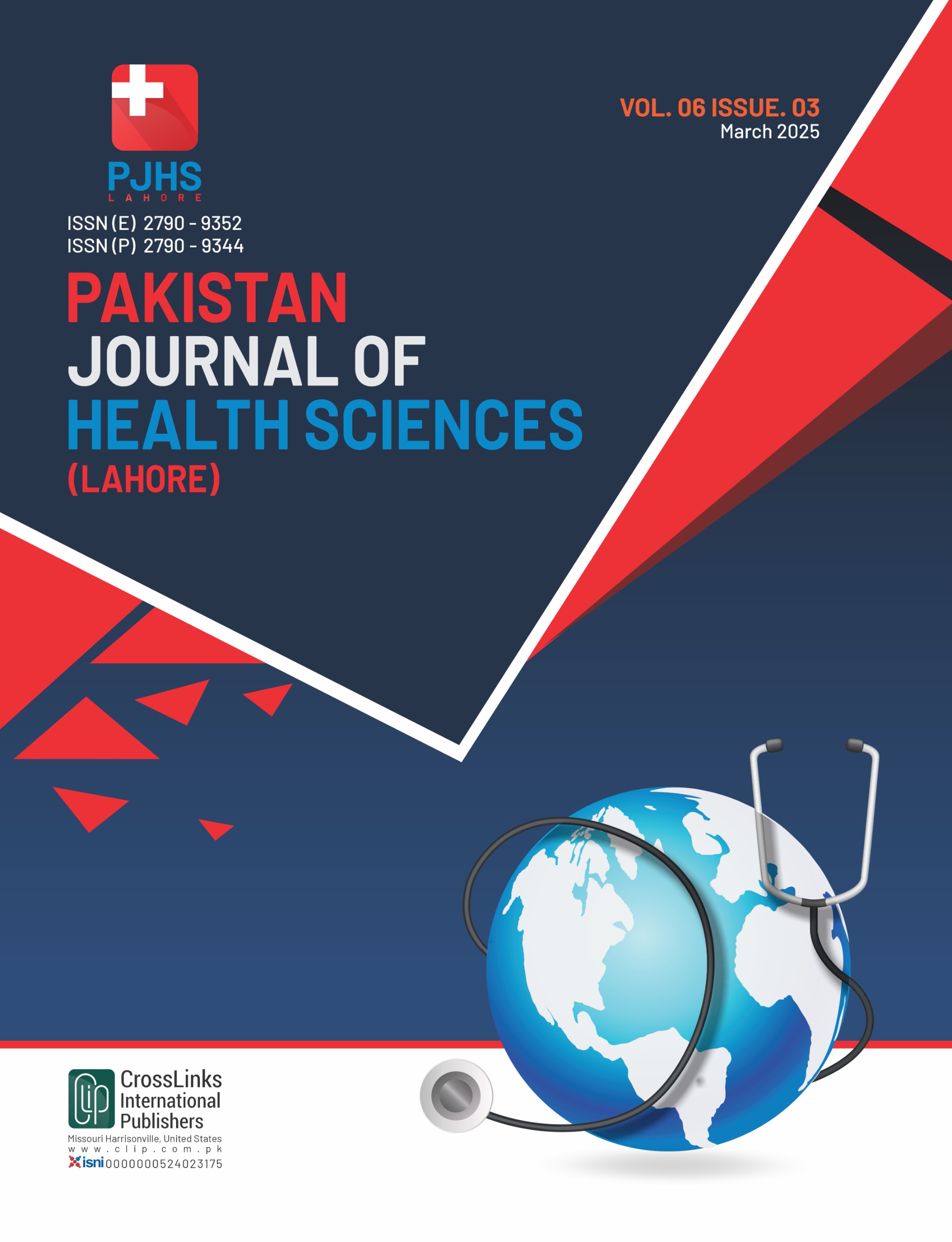Frequency of Vaginal Birth after C-Section and Factors Associated with Successful Trial of Vaginal Birth after C-Section
Vaginal Birth after C-Section Success and Factors
DOI:
https://doi.org/10.54393/pjhs.v6i3.2661Keywords:
Vaginal Birth after C-Section Success Rate, Maternal Factors, Obstetric Outcomes, Trial of LaborAbstract
A repeat cesarean section is often a more favorable and comfortable option for women who have previously undergone a cesarean section. Objective: To determine the prevalence and the maternal and obstetric factors influencing the likelihood of a successful vaginal birth after cesarean (VBAC) among women attempting a trial of labor. Methods: This descriptive case series was conducted at the Gynecology Unit 3 of Sir Ganga Ram Hospital, Lahore, from August 2023 to February 2024. A total of 158 women with a history of one prior lower-segment cesarean section were enrolled through a non-probability sampling technique. Labor progression was monitored using the WHO labor guide, which guided the decision for either a repeat cesarean section or a vaginal birth. Data on factors associated with a successful VBAC were collected and analyzed by comparing their frequency between successful and unsuccessful cases. Results: Among the women undergoing a trial of labor, 115 (72.78%) achieved a successful vaginal delivery. When comparing maternal and obstetric factors between successful and unsuccessful groups, the following differences were observed: maternal age below 30 years (55.65% vs. 39.53%), gestational age under 40 weeks (59.13% vs. 48.84%), BMI less than 25 kg/m² (57.39% vs. 30.23%), and an inter-delivery interval exceeding two years (80.0% vs. 60.47%). Conclusions: This study found that the success rate of vaginal delivery in women with a prior cesarean section undergoing a trial of labor was 72.78%. Several maternal and obstetric factors were associated with an increased likelihood of successful VBAC.
References
Ghukasyan NN. Analysis of the Caesarean Section Rate in Armenia for the Period 2016-2021 Based on the Results of a Single Center Study. Open Journal of Obstetrics and Gynecology. 2023 Jan; 13(1): 47-52. doi: 10.4236/ojog.2023.131005. DOI: https://doi.org/10.4236/ojog.2023.131005
Lurie S. The changing motives of cesarean section: from the ancient world to the twenty-first century. Archives of Gynecology and Obstetrics. 2005 Apr; 271: 281-5. doi: 10.1007/s00404-005-0724-4. DOI: https://doi.org/10.1007/s00404-005-0724-4
Doret M, Touzet S, Bourdy S, Gaucherand P. Vaginal birth after two previous c-sections: obstetricians–gynaecologists opinions and practice patterns. The Journal of Maternal-Fetal & Neonatal Medicine. 2010 Dec; 23(12): 1487-92. doi: 10.3109/14767051003678176. DOI: https://doi.org/10.3109/14767051003678176
Mi Y, Qu P, Guo N, Bai R, Gao J, Ma Z et al. Evaluation of factors that predict the success rate of trial of labor after the cesarean section. BioMed Central Pregnancy and Childbirth. 2021 Dec; 21: 1-9. doi: 10.1186/s12884-021-04004-z. DOI: https://doi.org/10.1186/s12884-021-04004-z
Jenabi E, Khazaei S, Bashirian S, Aghababaei S, Matinnia N. Reasons for elective cesarean section on maternal request: a systematic review. The Journal of Maternal-Fetal & Neonatal Medicine. 2020 Nov; 33(22): 3867-72. doi: 10.1080/14767058.2019.1587407. DOI: https://doi.org/10.1080/14767058.2019.1587407
Bălălău OD, Bacalbașa N, Olaru OG, Pleș L, Stănescu DA. Vaginal birth after cesarean section–literature review and modern guidelines. Journal of Clinical Investigation Surgery. 2020; 5(1): 13-7. doi: 10.25083/2559.5555/5.1/13.17. DOI: https://doi.org/10.25083/2559.5555/5.1/13.17
Rasool MF, Akhtar S, Hussain I, Majeed A, Imran I, Saeed H et al. A cross-sectional study to assess the frequency and risk factors associated with cesarean section in Southern Punjab, Pakistan. International Journal of Environmental Research and Public Health. 2021 Aug; 18(16): 8812. doi: 10.3390/ijerph18168812. DOI: https://doi.org/10.3390/ijerph18168812
Familiari A, Neri C, Caruso A, Airoldi C, Barone-Adesi F, Zanconato G et al. Vaginal birth after caesarean section: a multicentre study on prognostic factors and feasibility. Archives of Gynecology and Obstetrics. 2020 Feb; 301: 509-15. doi: 10.1007/s00404-020-05454-0. DOI: https://doi.org/10.1007/s00404-020-05454-0
Betran AP, Ye J, Moller AB, Souza JP, Zhang J. Trends and projections of caesarean section rates: global and regional estimates. British Medical Journal Global Health. 2021 Jun; 6(6): e005671. doi: 10.1136/bmjgh-2021-005671. DOI: https://doi.org/10.1136/bmjgh-2021-005671
Negrini R, da Silva Ferreira RD, Guimarães DZ. Value-based care in obstetrics: comparison between vaginal birth and caesarean section. BMC Pregnancy and Childbirth. 2021 Apr; 21(1): 333. doi: 10.1186/s12884-021-03798-2. DOI: https://doi.org/10.1186/s12884-021-03798-2
Antoine C and Young BK. Cesarean section one hundred years 1920-2020: the Good, the Bad and the Ugly. Journal of perinatal Medicine. 2021 Jan; 49(1): 5-16. doi: 10.1515/jpm-2020-0305. DOI: https://doi.org/10.1515/jpm-2020-0305
Davis D, Homer CS, Clack D, Turkmani S, Foureur M. Choosing vaginal birth after caesarean section: Motivating factors. Midwifery. 2020 Sep; 88: 102766. doi: 10.1016/j.midw.2020.102766. DOI: https://doi.org/10.1016/j.midw.2020.102766
Misra A. Impact of the HealthChoice program on cesarean section and vaginal birth after C-section deliveries: a retrospective analysis. Maternal and child health journal. 2008 Mar; 12: 266-74. doi: /10.1007/s10995-007-0234-z. DOI: https://doi.org/10.1007/s10995-007-0234-z
Dahlquist K, Stuart A, Källén K. Planned cesarean section vs planned vaginal delivery among women without formal medical indication for planned cesarean section: A retrospective cohort study of maternal short‐term complications. Acta Obstetricia et Gynecologica Scandinavica. 2022 Sep; 101(9): 1026-32. doi: 10.1111/aogs.14408. DOI: https://doi.org/10.1111/aogs.14408
Gimovsky AC, Frangieh M, Phillips J, Vargas MV, Quinlan S, Macri C et al. Perinatal outcomes of women undergoing cesarean delivery after prior myomectomy. The Journal of Maternal-Fetal & Neonatal Medicine. 2020 Jul; 33(13): 2153-8. doi: 10.1080/14767058.2018.1542680. DOI: https://doi.org/10.1080/14767058.2018.1542680
Davidson C, Bellows P, Shah U, Hawley L, Drexler K, Gandhi M et al. Outcomes associated with trial of labor after cesarean in women with one versus two prior cesarean deliveries after a change in clinical practice guidelines in an academic hospital. The Journal of Maternal-Fetal & Neonatal Medicine. 2020 May; 33(9): 1499-504. doi: 10.1080/14767058.2018.1520831. DOI: https://doi.org/10.1080/14767058.2018.1520831
Landon MB. Vaginal birth after cesarean delivery. Queenan's Management of High‐Risk Pregnancy: An Evidence‐Based Approach. 2024 Jan: 415-24. doi: 10.1002/9781119636540.ch47. DOI: https://doi.org/10.1002/9781119636540.ch47
Tesfahun TD, Awoke AM, Kefale MM, Balcha WF, Nega AT, Gezahegn TW et al. Factors associated with successful vaginal birth after one lower uterine transverse cesarean section delivery. Scientific Reports. 2023 May; 13(1): 8871. doi: 10.1038/s41598-023-36027-1. DOI: https://doi.org/10.1038/s41598-023-36027-1
Lipschuetz M, Guedalia J, Rottenstreich A, Persky MN, Cohen SM, Kabiri D et al. Prediction of vaginal birth after cesarean deliveries using machine learning. American Journal of Obstetrics and Gynecology. 2020 Jun; 222(6): 613-e1. doi: 10.1016/j.ajog.2019.12.267. DOI: https://doi.org/10.1016/j.ajog.2019.12.267
Zhang H, Liu H, Luo S, Gu W. Oxytocin use in trial of labor after cesarean and its relationship with risk of uterine rupture in women with one previous cesarean section: a meta-analysis of observational studies. BioMed Central Pregnancy and Childbirth. 2021 Dec; 21: 1-0. doi: 10.1186/s12884-020-03440-7. DOI: https://doi.org/10.1186/s12884-020-03440-7
Majzoobi MM, Majzoobi MR, Nazari-pouya F, Biglari M, Poorolajal J. Comparing quality of life in women after vaginal delivery and cesarean section. Journal of Midwifery and Reproductive Health. 2014 Oct; 2(4): 207-14. Doi:
Memon S, Naseem HK, Devi D, Kanta Bai MA, Aamir K, Ramzan A. Frequency of fetal and maternal complications after C-section in vaginal deliver. Pakistan Journal of Medical & Health Sciences. 2023 Jun; 17(04): 402. doi: 10.53350/pjmhs2023174402. DOI: https://doi.org/10.53350/pjmhs2023174402
Stennett CA, Dyer TV, He X, Robinson CK, Ravel J, Ghanem KG, et al. A cross-sectional pilot study of birth mode and vaginal microbiota in reproductive-age women. PLoS One. 2020 Apr; 15(4): e0228574. doi: 10.1371/journal.pone.0228574. DOI: https://doi.org/10.1371/journal.pone.0228574
Grylka-Baeschlin S, Petersen A, Karch A, Gross MM. Labour duration and timing of interventions in women planning vaginal birth after caesarean section. Midwifery. 2016 Mar; 34: 221-9. doi:10.1016/j.midw.2015.11.004. DOI: https://doi.org/10.1016/j.midw.2015.11.004
Downloads
Published
How to Cite
Issue
Section
License
Copyright (c) 2025 Pakistan Journal of Health Sciences

This work is licensed under a Creative Commons Attribution 4.0 International License.
This is an open-access journal and all the published articles / items are distributed under the terms of the Creative Commons Attribution License, which permits unrestricted use, distribution, and reproduction in any medium, provided the original author and source are credited. For comments













